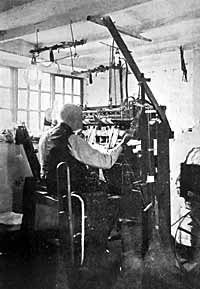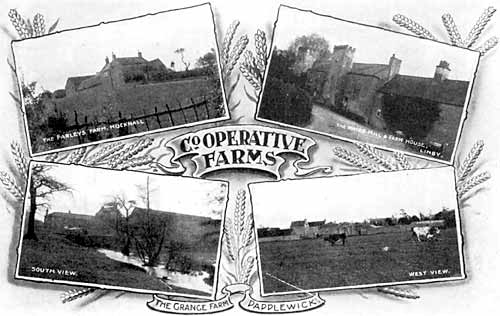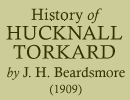< Previous | Contents | Next >
THE HOSIERY TRADE.

A stocking frame.
The invention of the stocking frame is attributed to the ingenuity of the Rev. Wm. Lee, M.A., curate of our neighbouring village of Calverton, in A.D. 1559. Deering, the Notts, historian, says Lee was deeply in love, but his sweetheart seemed more intent upon her knitting than upon the curate's vows, and he was induced to contrive a machine which should supersede hand-knitting.
Another authority states that Mr. Lee was a poor married man, whose wife helped up the family income by knitting.
It is certain that a Mr. Lee showed his loom to Queen Elizabeth, but as his invention was not sufficiently appreciated at home, he went with some workmen to France, where Henry IV. patronised him, and he died in Paris.
The English framework-knitters then returned to London, where they established the Framework-Knitters Company, but the industry soon afterwards was introduced to Notts., where it has flourished ever since. In the year 1669 there were 660 frames in the counties of Notts., Derbyshire, and Leicestershire; in 1782 these had increased to 20,000, and in 1844 there were 43,482.
In Calverton Church burial register occurs the following entry:—"Joseph Lee, stockinger (the last of the family of the stocking-frame inventor, Lee) in this parish, buried 17th November, 1755. The stocking manufacture very bad last year, and work here is so scarce that not enough to be got for half the bellies to be filled. The Lord have mercy on the poor."
At this period stocking-weaving, agriculture, with a little lime-burning, were the staple industries in Hucknall.
The Church Register in the years 1717, 1719, and 1721 records the fact that Joseph Hodges, Samuel Starr, and William Spray, who were married in those years, were framework-knitters.
The story of the Luddite rising and frame-smashing is told in a succeeding chapter in this book.
Robert Lowe, in his "General View of Agriculture in Notts.," published A.D. 1798, names the following cotton-spinning mills on the Leen:—"Robinson's Upper Mill, Old Mill, New Mill, Middle Mill, Forge Mill, and Nether Mill." The last-named was probably in the Bulwell parish. The Mr. Robinson here referred to lived at Papplewick Grange, and was a man evidently possessed of great business talent, energy, and capital. He founded the "Moore and Robinson's Bank " at Nottingham, Mr. Moore being one of his head cashiers in the spinning business.
To-day the sites of some of these old mills are plainly to be seen, and the names that survive are the Weir Mill, Castle Mill, Warp Mill, Middle Mill, and Forge Mill. Forge Mill, as has been already noticed, was originally a forge in A.D. 1757, according to the "Nottingham Date Book. David Lowe, of Nottingham, who was said to be double-jointed, "once lifted from the ground the large hammer, weighing 7cwt., at the Forge Mill."
There was an ancient mill at the foot of the top lake in Newstead Park, the remains of which are seen at the waterfall. In the poet's time tradition says he occasionally resorted thither to be weighed.
It was commonly reported, near the close of the 18th century, that the little River Leen had along its banks more cotton and flour mills than any similar stretch of stream in the country. Seventy acres of water courses and reservoirs were constructed to turn the water wheels, and one of the largest wheels, measuring 44 feet in diameter, was in operation at Papplewick. After the expiration of the leases in 1840 most of the mills were dismantled and the water courses filled up. The introduction of steam power and the "Spinning Jenny," coupled with the cost of carriage of yarn, in wagons from Liverpool, killed the Leen Valley spinning industry, and it is possible that had the railways been established before 1820 this district might have become the great cotton-working district in the kingdom.
It is worthy of mention that Watts' first steam engine, designed to turn the wheel with crank action, was used at one of Mr. Robinson's Papplewick Mills.
This reference to the mills is made because a number of the workers lived in Hucknall as well as at Papplewick and Linby.
The pauper boys, drafted out of the London Workhouses to work at these mills, do not appear to have lived at Hucknall, because they were buried in Linby Churchyard by scores, victims probably of overwork and underfeeding.
The father of our well-known townsman, Mr. Ben Axford, was a London boy, hailing from Red Lion Square, and he frequently referred to the hardships of the Napoleonic days, when bread was so costly that he could eat seven of the minute penny loaves for his breakfast.
In 1821 there were 330 families dwelling in Hucknall, of whom 70 were engaged in agriculture and 220 in trade, the majority of the latter being employed in stocking-making, and some in the Papplewick Mills.
In 1844 there were 301 shops containing 815 frames, which were being worked, and 158 frames were in the smiths' hands. In that a year, at a Parliamentary Commission of Enquiry, evidence was given by William Hutchinson (wrought hose-maker), John Heritage, John Keywood, John Burton, Thomas Neale, John Norman, Mark Gamble, John King, Joseph Saxton (fancy branch), Samuel Webster (plain wrought hose), and Matthew Limb.
On page 195 of the Report Wm. Hutchinson's statement is given as follows:—"He had worked 53 years in the frame. He asserted that a person who had a family subsisting on a small sum was sure to suffer privations, and many had to do that who worked very hard for 15, 16, and perhaps 17 hours a day. He thought the Corn Law in 1815 was the first thing that affected them. There were 25 acres of allotments recently divided for the accommodation of the inhabitants of the town. It was expected these would benefit the poor, but the land was only entered upon this Spring."
John Heritage said "there was very little 'trucking' done at Hucknall to what there used to be."
John King said he made one dozen per week, for which he received 10s. Out of the 10s. he had to pay 2s. 6d. for frame-rent; his wife seamed the hose, and his needles cost him 41/2d., and candles 3d.
About the year 1840 glove-making was introduced into this district, and continued till 1864, giving employment to about 200 people (and to 700 at Bulwell), but a change of method in manufacture, coupled with a disastrous strike, demolished the trade.
About the year 1852 (said the late Mr. Andrew Radford) the Shetland hosiery industry sprang up, and gradually gave employment to the men who had been previously engaged in spider-work stockings and gloves. Mr. Radford told the writer that Mr. James Wood, of Nottingham, bought a knitted fall in the Shetlands and asked Mr. Robert Widdowson, postmaster and stocking-maker, if he could not make something similar on a frame. Mr. Widdowson submitted the task to Messrs. Wm. and Thomas Farrands, who were aided by Mr. Ben Woollatt, in adapting a frame for this class of work, and very soon Messrs. William Barker, William Calladine, Michael Wilkinson, Henry Rhodes, Joseph Stainforth, Thomas Dawson, and Reuben Cale were engaged in this class of manufacture.
A little more than 30 years ago many journeymen were tempted by the boom in this trade to set up as master hosiers, but the period of depression which supervened reduced their numbers, so that to-day the leading firms in this industry are Messrs. H. and I. Rhodes, Wm. Woollatt, Wm. J. Calladine, and John Buck, and the principal foreign markets for their produce have been America, Russia, France, and Spain.
About the year 1884 Mr. H. Rhodes introduced the manufacture of Orenburg shawls, an imitation of the knitting of the peasant women in the Caucasus and Western Russia. So fine is this work that a shawl measuring two yards square, and containing from a million to 1,300,000 loops, and weighing less than 21/2 ounces, can be pulled through a finger ring.
Stocking-making on the old frames may now almost be counted as a dead industry, for instead of hundreds of people being engaged at the work, less than a hundred, all told, are now employed. The decay began with the invention of better machinery, patented by Cotton, and later on the Griswold seamless machine was brought out in the United States, followed by the Scott-William patents, whereby one girl can manage four machines at once, and one Hucknall clever girl has worked off 90 dozen pairs in one week.
The Raynors have for about 100 years been engaged in this work, and Mr. John Raynor, together with Mr. John Wagstaff, were awarded gold medals at the British Workmen's Exhibition in London, for excellent workmanship. Mr. Samuel Green was awarded a silver medal and certificate at the 1900 Paris Exhibition for underwear, and Mr. J. Stretton (employed by Mr. J. A. Hardy) was similarly recognised for the lace-ankled stockings he made.
Messrs. Raynor have made hose for the German Emperor (through Messrs. I. and R. Morley) and for the Czar (through Messrs. Ashwell). Mr. S. Green has made hosiery for King Edward, the German Emperor, and the Dowager Empress of Russia.
Mr. Matthew Limb was the leading Hucknall stocking-maker in the earlier part of the 19th century, and employed 100 workpeople. He was straightforward, but eccentric, and his peculiar business methods have afforded food for fireside gossip ever since.
The late Mr. S. Morley, who foresaw the decay of the old system of framework-knitting, devised a pension scheme for old workpeople, and allowed them 7s. 6d. to "keep them off the parish." There were fifteen of these Morley Pensioners at one time, the last of whom were John Rickett, of Millott's Yard, and William Whyatt, of Beardall Street, who have died within the last few years.
The earnings of a framework-knitter 100 years ago was about 10s. for a heavy week's work, but the average was nearer 8s. The wife and children had to work as soon and as long as they were able, the children winding the yarn and seaming the hose. The late Churchwarden, John Raynor, said in his earlier days many women and children spent the winter in the workhouse, and those who stayed at home were compelled by poverty to feed on beans, peas, wild fruit, turnips, potatoes, and barley bread. Clothes and coal were dear, and stick-gathering in the fields and lanes was regularly resorted to for cottage fires.
The frame-rents paid by the workmen were a source of agitation for many years, but these were finally abolished about the year 1872.
CO-OPERATIVE MOVEMENT.
 |
This agency for the social improvement of Hucknall dates back to the year 1828, when a little society was formed, and a shop opened in Ball's Yard, West Street. A feature of this society was the selling at various members' houses. Mr. J. Hall was manager, and Messrs. Jarvis Cartledge and James Buck were prominent among the founders.
A move was made to South Street, where Mr. Wm. Calladine was the manager, and he continued in office at the Stores opened subsequently at the Market Place corner of High Street. Mr. Calladine was succeeded in the management by Mr. Goodliffe and Mr. Roby Rowe.
The Central Post Office was built for the Society, at a cost of £500, on the Duke of Portland's land, and Mr. Rowe found, on entering office, that the credit system had severely crippled the Society, which lingered on till 1865, and on being wound up paid 17s. 6d. in the £.
The present Society was founded on the cash payment system in 1864, after lectures in the National School and Half Moon Club-Room by Mr. T. Hardy, who beforetime had been partly instrumental in founding a Society at Quorndon, in Leicestershire. The prominent leaders in the new Society were Messrs. George, James, and Samuel H. Brown, John Rickett, S. Mellows, George Hatfield, Thomas Dove, Joseph and William Howitt, William Betteson, T. Hardstaff, John Newsome.
A shop, for selling at nights, was opened in Gilbert Street in 1864, and in 1865 a move was made to Watnall Road (opposite Beardall Street). A branch was opened near Whyburn Street in 1868, and a new and more commodious central store was built in 1874, on Watnall Road, on the land which had been bought at the Rev. Curtis Jackson's sale. Since then the history of the Society has been one of steady growth. New branches were established successively at George Street (1876), Kimberley (1883), Newstead, Market Place (1898), High Street, Kimberley No. 2, and Charles Street.
Among the useful developments of the Society the purchase of nearly 4 acres of land near the Cricket Field, in 1900, for cottage building, may be mentioned.
In 1901 an essay into farming was made by entering the tenancy of Farley Farm of 168 acres, part of which is in Hucknall and part in Bulwell parish. To-day 58 acres are laid down for grass and 110 acres arable. In 1904 the Grange Farm of 280 acres, in Papplewick, Linby, and Hucknall, was entered upon. There are this year 85 acres of grass and 195 arable. Both farms are in a promising state, according to the Valuer's Report.
There are 3468 members of the Society, and 124 persons are employed. The sales average about £100,000 per annum, and the share capital totals £94,689, or an average of £32 per member.
